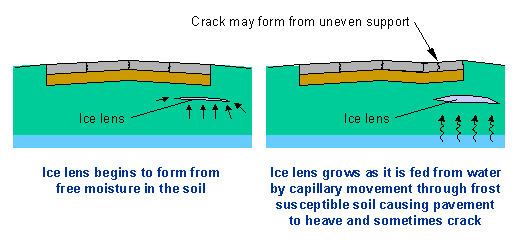The heaving itself is caused by the formation of ice lenses in the soil below the pavement. Water expands 9% by volume when frozen. The size of the an ice lens depends upon the quantity of free water available within the soil and from the water table, and time. When the soil freezes, the free water freezes and expands. Once started, ice lenses continue to grow as long as a source of free water is available. Free water migrates through the soil to a forming ice lens by capillary action (akin to wicking). This migration of water can be as far as 20 feet for certain frost susceptible soils.
Formation of Ice Lens and Frost Heave

Eliminating the supply of water to the soil below the pavement is virtually impossible. However, good drainage can partially reduce the quantity of water available to feed an ice lens and cause frost heave. Much of this supply of water from below can be cut off with combinations of sand blankets and tile drains.
Some soils are more susceptible to the formation of ice lenses than others. Silts or silty clay soils are considered amongst the most frost susceptible. Silt, because of the extremely small size of its particles, or gradation, permits and encourages the flow of water by capillary action through its pores. Consequently, silts supply the water necessary to promote the formation of ice lenses in the freezing zone. Other soils considered frost susceptible include fine sands, clayey gravel and rock flour. Moderately frost susceptible soils include dirty sands and gravels and glacial tills.
The only soils that can be considered to be non-frost susceptible are very clean mixtures of sand and gravel. These soils drain freely by gravity and do not create capillary moisture movement.
Frost heave is most often found at the following locations:
- Transitions from cut to fill
- Where ditches are inadequate or non-existent
- Over culvert pipes
- Adjacent to driveways that dam roadside ditches and/or collect water
- Where ever there is an abrupt change in subgrade material
Not all frost heaving is detrimental to a pavement. Uniform heaving will likely not be noticeable to the eye or to vehicle passengers. There are no bumps or rolls, the whole road has heaved uniformly and therefore presents no maintenance problem. Heave is destructive and troublesome only during the freezing or frozen phase, when it varies sharply, causing uneven support to the pavement.
To prevent frost heave, highly susceptible soils should be replaced or stabilized. Frost heave spots should be drained with tile drains and/or ditches should be kept clean and free of clutter that prevents flow of water away from the pavement.


